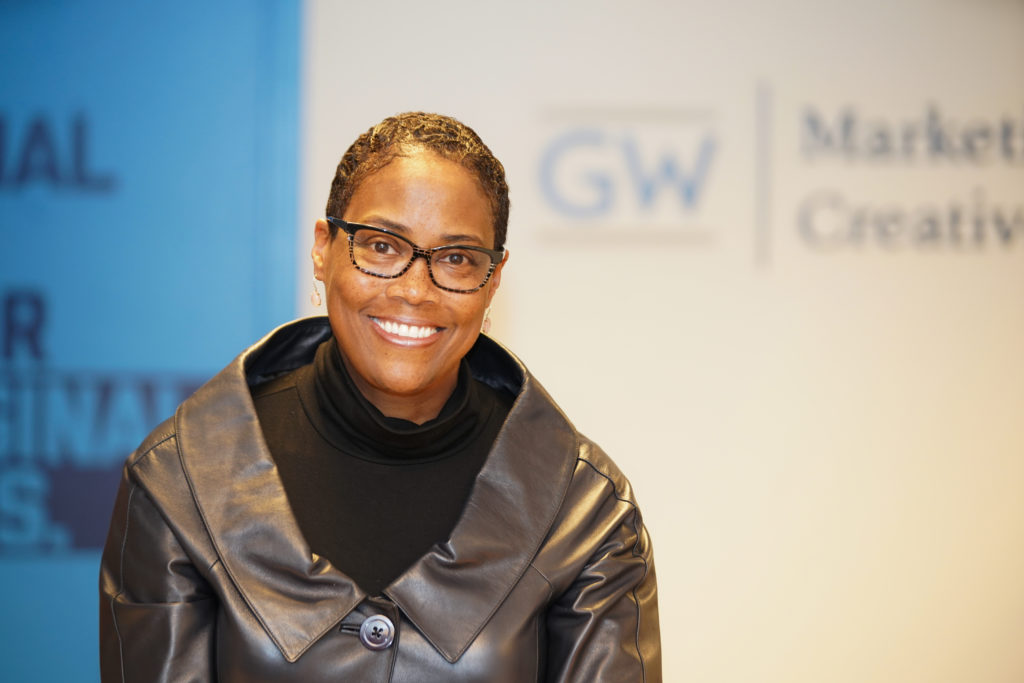GW’s first-ever chief people officer has spent her first semester working to make employees feel more welcome at the University.
Dana Bradley, who took over the University’s top human resources post Sept. 3, said her biggest priority since coming to campus has been “putting people first” as part of a broad overhaul of the HR department in her first sit-down interview with The Hatchet. Bradley, the first person to hold the title of chief people officer at GW, has helped lead a push by University President Thomas LeBlanc to improve GW’s institutional culture.
“I love HR, but what sold me on GW and what made me think that this was the best thing ever is the culture work,” Bradley said. “I think that our president, our provost and our executive vice president have been bold in what our aspiration is, and I think that there’s something to be said that we in our broader community, students, staff and faculty will benefit from all the work that’s underway.”
She said that since arriving at GW, she spent her first few months on the job meeting with every dean, every vice president and other staff and faculty across the University. Many employees have told her that they want GW’s HR processes to have a larger “community focus” by incorporating the voice of each employee in top decision-making, Bradley said.
“When I think about those meet and greets, I use it as a way to collect data,” Bradley said. “And I’m asking them, ‘what are our opportunities? What is it that we do that you want us to continue?’ And then I’m also using it as an opportunity to collect their input on what they think that we should improve or change.”
As CPO, Bradley serves as a member of the Culture Leadership Team – a group of roughly 10 officials overseeing LeBlanc’s institutional culture initiative. Since her arrival, administrators have held culture training sessions for all faculty and staff, which have encountered mixed reactions from faculty.
As the University enters the second year of its extended partnership with the Disney Institute, which is part of the culture initiative, Bradley said she visited the Disney Institute last month with about half of the human resources staff to learn from their processes. A Disney Institute staff member will visit the remaining HR staff on campus to impart lessons from the visit, Bradley said.
“I’ve been fortunate because early on the culture initiative had rolled out, and they brought me on the Culture Leadership Team, so I’ve had my voice,” she said.
Bradley said she did not know how much money officials have spent on the Disney Institute partnership. Officials have continually declined to comment on the cost of the partnership.
The HR staff on the Disney Institute trip included Marlon Sukal, who administrators hired last month to serve as GW’s assistant vice president for talent and organizational development. Sukal, who oversees employee engagement and onboarding, reports directly to Bradley.
Faculty passed a petition in October calling on four Faculty Senate committees to investigate the costs of the partnership, but officials have not provided the requested information.
Sylvia Marotta-Walters, the chair of the Faculty Senate and a member of the Culture Leadership Team, said Bradley’s participation in the Culture Leadership Team is “crucial” because her background in HR and talent development has provided valuable expertise and a fresh perspective as officials continue to make progress on the initiative.
“Every aspect of the University is going to continue to have the elements of the service framework implemented,” she said.
LeBlanc said Bradley will continue to build on the culture initiative’s progress in her role.
“Dana’s going to be working with the senior administration, looking at everything we do, from recruitment, orientation, training opportunities, promotion opportunities,” he said. “We’re going to try to become a model organization.”
He added that having a top official dedicated to developing GW’s employees helps improve the University’s institutional culture by serving as an outlet for their views at the highest levels of decision-making.
“It’s a lot of work and obviously she has only been here four months, but having that chief people officer voice at the table in the leadership representing those issues, I think, is really important,” LeBlanc said.








